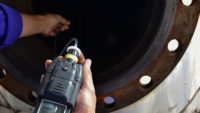Managers and supervisors in the construction and manufacturing industries need to protect their employees from various work-related hazards, including the presence of silica dust. These particles can spread through the air when drilling, cutting, grinding, or sanding certain types of materials, including drywall, concrete, brick, stone and mortar. Exposure to silica dust can result in a range of adverse respiratory health effects, including lung diseases like silicosis and cancer. Symptoms include shortness of breath, chest pains, and difficulty breathing.
Like many workplace hazards, silica dust in the air can be measured to help workers and managers monitor exposure levels. Preventing exposure often requires a combination of control methods, such as ventilation and water spray systems and PPE, including respirators. OSHA’s Respirable Crystalline Silica standard is designed to help businesses large and small keep their workers safe on the job.
OSHA silica rules and regulations
OSHA’s current silica rules and regulations went into effect in 2016. This ruling sets the permissible exposure limit (PEL) for respirable crystalline silica at 50 micrograms per cubic meter of air over the course of an 8-hour shift. If the workplace surpasses the acceptable limit of silica dust, the staff will need to implement control measures, wear PPE, or use some combination of the two to reduce exposure.
Regardless of which method is chosen, OSHA requires all construction and manufacturing employers to:
- Establish and implement a written exposure control plan, including a list of all exposure and control methods used to protect workers, as well as operational guidelines that restrict worker access to potentially dangerous activities or environments.
- Designate an experienced manager or supervisor to implement the written exposure control plan.
- Avoid practices that expose workers to silica when practical alternatives are available.
- Offer medical exams-including chest X-rays and lung function tests-every three years for workers who are required to wear a respirator for 30 or more days per year as per the standard.
- Train workers on work operations that result in silica exposure and ways to limit exposure.
- Keep records of exposure measurements, objective data, and medical exams.
How to comply
Managers and staff in work areas where silica dust is known to be a potential hazard must take a series of steps to understand the scope of the threat before they can find an adequate solution.
Testing
It begins with testing the work area regularly for the presence of silica dust. Workers should don personal sampling pumps worn in the breathing zone, the area around the person’s nose and mouth, to test the air they will be breathing in on the job. The pump will pull air through a specially designed filter cartridge, which can then be sent to a lab for analysis of the estimated volume of silica dust in the air. The air will need to be tested throughout a traditional 8-hour shift to account for any changes throughout the day.
The company is required to test the worksite every three to six months and report any changes in silica dust levels. For a more detailed assessment, the staff can also consult with a workplace hygienist or safety inspector that will test the workplace on their behalf.
Control measures
Once air quality has been analyzed, the staff should look for ways to naturally reduce the amount of silica dust present in the atmosphere. Possible control methods may include using a water spray system, increasing ventilation by opening windows, fans, or having workers complete potentially dangerous tasks outside.
The company will need to identify the source of the silica dust before these control measures can be implemented. Staff should find out which activities or equipment are creating the problem. These activities may need to be relocated to a secure location to prevent exposure. For example, workers may need special access to reach these worksites so other individuals don’t come in contact with the particles. Workers performing these tasks may also need to use different equipment or change the way they use these machines to limit their exposure.
OSHA provides a list of additional task-specific resources and guides on how to reduce the presence of silica dust in the workplace, including those for individual pieces of equipment and construction materials.
PPE and worker safety
If the level of silica dust in the air still surpasses the acceptable threshold after these control measures have been implemented, workers in these environments will need to wear the proper safety equipment. Experts recommend using a respirator with a NIOSH rating of N95 or higher, such as P100. N95 respirators capture 95% of dust particles in the air. They fit over the person’s nose and mouth, and finding the correct size is essential. There should be no gaps between the person’s skin and the respirator seal.
Managers must supply respirators in a range of sizes to ensure every team member can find one that fits the exact size and shape of their head. They may also want to provide disposable N95 respirators or “dust masks” as an alternative for protection against silica dust. The mask should fit comfortably without impeding the person’s ability to do their job. Masks that feature an exhalation valve offer the most comfort and easiest breathing for the wearer.
Fit testing is required to ensure dust cannot get inside the mask. If the worker has a full beard or facial hair, they may need to wear a PAPR respirator hood that fits over their entire head instead.
Beyond providing the right respiratory PPE and ensuring they fit properly, employers must also ensure the equipment is maintained, repaired, and replaced when necessary. Respirators should be kept in a secure, enclosed location when they are not in use and fresh filters should be readily available.
Reducing exposure to silica dust is the employer’s responsibility, but everyone can do their part to improve workplace safety. Workers must wear the proper safety gear when control measures are not enough to reduce the spread of hazardous particles.



